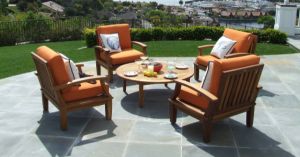When buying custom slipcovers or replacement slipcovers for patio furniture, one of the most important considerations is the type of fabric. That is, slipcovers for outdoor furniture are subjected to particularly harsh conditions and, as such, their fabric properties may be just as important as, or more important than, the color and pattern of the fabric. Here are five factors to consider when choosing a fabric for patio furniture slipcovers:
Durability
Outdoor patio furniture can see a lot of abuse not experienced by indoor furniture. From hot barbecue utensils to rambunctious kids with baseball bats, patio furniture cushion covers have to be able to withstand a lot of abuse without tearing. Synthetic materials, such as nylon, polytetrafluoroethylene (or PTFE), polyester vinyl, and acrylic, are usually more durable than natural fabrics. However, these synthetics, like all plastics, are made from non-renewable resources like petroleum. Moreover, some plastics are produced using bisphenol A (or BPA) as a plasticizer. BPA has been linked to possible health problems, including metabolic and reproductive disorders. Natural materials, such as hemp and cotton, are usually not as durable as synthetics. However, when blended with synthetics or treated with a synthetic coating, they may approach the durability found in synthetic materials. Hemp, for example, is one of the most durable natural fibers available. When blended with polyester, hemp becomes even more durable and the resulting fabric takes on some of the other properties discussed below, such as water and stain resistance.
UV Resistant
Ultraviolet (or UV) rays can cause a variety of problems for patio furniture and patio furniture cushion covers. Damage to paint and fabrics exposed to the sun is caused by a combination of UV radiation, visible light, and heat, with about 40% of the damage being caused by UV-A and UV-B rays. UV-B rays primarily affect the surface of cushions, causing colors to fade. UV-A rays are more damaging and can cause the fabric of slipcovers and even the material inside the cushion to degrade. Certain materials are more resistant to UV rays than others. For example, synthetic materials such as polyester vinyl and nylon are susceptible to UV degradation while PTFE and acrylic are not. Similarly, cotton and wool will fade and yellow under exposure to UV radiation, while hemp is naturally UV resistant. Most materials can be treated with UV stabilizers to absorb UV radiation and reduce the fading and degradation caused by the sun.
Stain Resistant
Stain resistance is partly a function of the material used to produce the fabric and partly a function of the way the fabric is woven. For example, fabric made from synthetic materials tends to resist stains because the plastic fibers cannot be penetrated by the stain. Moreover, materials like PTFE (also known by its trade name Teflon) are too slippery for stains to stick. For this reason, PTFE and other synthetics are used to treat fabrics to confer stain resistance. Similarly, tightly woven fabric, whether natural or synthetic, tends to maintain its shape and repel dirt and stains because the weave leaves few gaps for the stain to penetrate. Hemp is not necessarily resistant to stains, but stains often can be laundered out of hemp fabric because the structure of hemp allows it to shed an outer layer of cells. Thus, stains that would be permanent in other fabrics can often be removed from hemp fabric with normal laundering.
Water Resistant
Whether from a rain shower or lawn sprinklers, patio furniture cushion covers are inevitably exposed to water. However, patio furniture cushion covers do not need to be waterproof. In fact, waterproof cushion covers may cause more problems than they solve by trapping moisture inside the cushion allowing water and mold damage to occur. Breathable, water resistant cushion covers, on the other hand, allow cushions to dry out, reducing the risk of mold and water damage.
Mold Resistant
Resistance to mold and other microorganisms is almost entirely a property of the material itself. Mold can grow anywhere that it can find darkness, water, and food. Cotton, for example, can hold moisture, block light, and provide a food source for mold. Hemp and synthetics, on the other hand, are inherently mold resistant since they do not provide a food source for mold.

